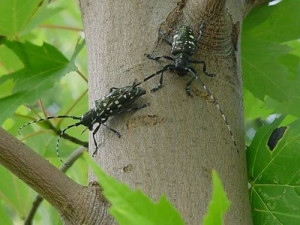Asian Longhorned Beetle Update: New Eradication Program to Begin
By Chris Williams on February 10, 2014.
 Chances are pretty good that if you live in New England, you’ve heard of this devastating forest pest. While most states in the region have escaped the consequences of having an established ALB [Asian Longhorned Beetle] population running rampant, people living in Massachusetts Worcester county know full well of the impact this invader from Asia.
Chances are pretty good that if you live in New England, you’ve heard of this devastating forest pest. While most states in the region have escaped the consequences of having an established ALB [Asian Longhorned Beetle] population running rampant, people living in Massachusetts Worcester county know full well of the impact this invader from Asia.
From the initial discovery in Brooklyn during the summer of 1996, outbreaks of Asian Longhorned beetle (Anoplphora glabripennis) have been discovered in several communities around NYC and Long Island, New Jersey, Chicago, Boston, Worcester, and now Ohio. (Alsop) The ‘cure’ for the outbreak calls for drastic measures.
First step is to survey the area to identify infested trees, then set up a quarantine area to try and contain the movement of all potentially infested wood products from host trees within the area (basically logs, brush, firewood etc.) and then finally the removal and destruction by chipping of all host trees within that zone. More than twenty thousand trees were removed and destroyed in that first eradication effort in and around NYC. Worcester however holds the distinction for now of being the worst area of ALB infestation in the US thus far. The quarantine zone was expanded from approximately sixty-two square miles to ninety-eight square miles in 2011 three years after initial eradication efforts began. All totaled, it is estimated that over thirty one thousand trees were destroyed in Worcester and several surrounding communities in order to fight the insect.
The battle against ALB will no doubt continue on for decades and the costs to control it will be huge, but the economic impact of not containing it could be staggering. ALB represents an existential threat to our forested lands, as we know them because of its wide host range. Unlike the Emerald Ash borer which is highly destructive, but only to native ash species, ALB attacks ash, poplar, birch, maple, elm, willow, and horse chestnut and many other species. Just imagine what the landscape would look like in New England without our many species of maple trees showing their glorious fall colors and you’ll get the picture.
There have been some successes in the eradication efforts thus far in places like Chicago, Illinois, and Hudson County, New Jersey, and Islip, New York. The eradication program is also having good results in the Worcester area. ALB has had resurgence in 2013 though in a couple of communities out on Long Island (Farmingdale and Amityville), which had not seen beetle activity since 2008. A new eradication program was begun in Clermont County Ohio in 2011 where up to nineteen thousand trees were destroyed to combat ALB, and an additional seventy two hundred trees to be destroyed during the fall of 2013 in an area near the East Forest State Park.
For more information and references used to create this article visit: